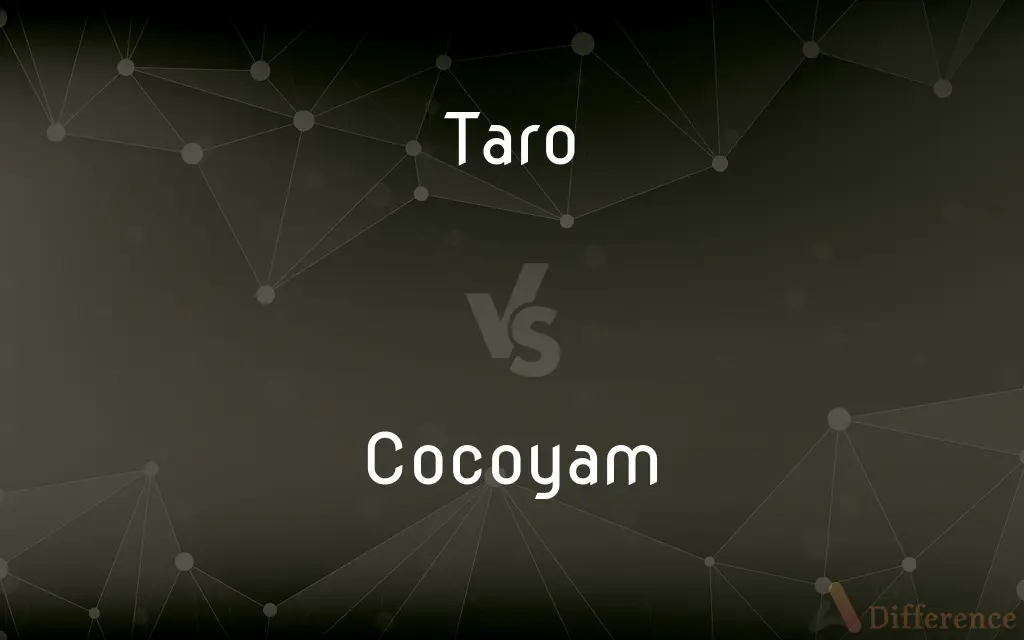Taro vs. Cocoyam — What's the Difference?
By Tayyaba Rehman & Urooj Arif — Updated on February 27, 2024
Taro is a root vegetable known for its large, elephant ear-like leaves, while cocoyam refers to similar root crops, including taro and malanga, with subtle taste and texture differences.

Difference Between Taro and Cocoyam
Table of Contents
ADVERTISEMENT
Key Differences
Taro, scientifically called Colocasia esculenta, is a staple root vegetable in many tropical regions, prized for its starchy corms. Cocoyam, on the other hand, often encompasses a broader category of root vegetables, including taro and other species like Xanthosoma, known for their edible corms and leaves.
Taro is characterized by its large, heart-shaped leaves and thick, fibrous roots. It requires careful preparation to remove oxalates, which can be irritating. Cocoyam varieties, such as malanga, may have different textures and flavors, with some being nuttier and less prone to irritation when eaten.
The cultivation of taro is widespread in Asia, Africa, and the Pacific Islands, where it's a key ingredient in traditional dishes. Cocoyam, while also popular in these regions, might refer to different species depending on the local context, affecting culinary uses and nutritional profiles.
Taro is a good source of fiber, vitamins, and minerals, offering health benefits such as improved digestion. Cocoyam, similarly nutritious, can vary in its specific nutrient content based on the variety, but generally provides a similar range of health benefits.
Comparison Chart
Scientific Name
Colocasia esculenta
Varies (e.g., Xanthosoma sagittifolium)
ADVERTISEMENT
Leaf Shape
Large, heart-shaped
Varies, generally large
Taste & Texture
Mild, slightly nutty, starchy
Can be nuttier or creamier
Preparation
Requires cooking to remove oxalates
Preparation varies by species
Nutritional Benefit
High in fiber, vitamins, minerals
Similar, with variations among species
Compare with Definitions
Taro
Taro requires thorough cooking to neutralize oxalates.
Before making taro chips, the slices need to be boiled.
Cocoyam
Cocoyam refers to several root vegetables, including taro and malanga.
In many African dishes, cocoyam is used as a thickener.
Taro
Taro is a starchy root vegetable used widely in global cuisines.
Taro root is often made into a creamy dessert in Asian dishes.
Cocoyam
It is versatile in culinary uses, from soups to desserts.
Cocoyam can be mashed as a side dish for savory meals.
Taro
Its leaves are also edible when cooked properly.
Taro leaves are used in making the Hawaiian dish called laulau.
Cocoyam
Cocoyam cultivation is similar to taro, requiring moist soil.
Like taro, cocoyam grows well in partially submerged conditions.
Taro
It is a perennial, tropical plant that thrives in wet conditions.
Taro fields are typically flooded with water for cultivation.
Cocoyam
The term 'cocoyam' can vary in meaning by region, often encompassing a range of tubers.
In the Caribbean, cocoyam is often referred to as dasheen or eddo.
Taro
Taro can be processed into flour, chips, and other products.
Taro flour is a gluten-free alternative for baking.
Cocoyam
Some varieties of cocoyam have leaves that are also edible.
Cocoyam leaves are a nutritious addition to stews.
Taro
Colocasia esculenta is a tropical plant grown primarily for its edible corms, a root vegetable most commonly known as taro (), kalo, dasheen, madhumbe, marope, magogoya, patra or godere (see §Names and etymology for an extensive list). It is the most widely cultivated species of several plants in the family Araceae that are used as vegetables for their corms, leaves, and petioles.
Cocoyam
Cocoyam is a common name for more than one tropical root crop and vegetable crop belonging to the Arum family (also known as Aroids and by the family name Araceae) and may refer to: Taro (Colocasia esculenta) - old cocoyam Malanga (Xanthosoma spp.) - new cocoyamCocoyams are herbaceous perennial plants belonging to the family Araceae and are grown primarily for their edible roots, although all parts of the plant are edible. Cocoyams that are cultivated as food crops belong to either the genus Colocasia or the genus Xanthosoma and are generally composed of a large spherical corm (swollen underground storage stem), from which a few large leaves emerge.
Taro
A tropical Asian plant of the arum family which has edible starchy corms and edible fleshy leaves, especially a variety with a large central corm grown as a staple in the Pacific.
Cocoyam
Edible starchy tuberous root of taro plants
Taro
A widely cultivated tropical Asian aroid plant (Colocasia esculenta) having broad peltate leaves and large starchy edible corms.
Cocoyam
Tropical starchy tuberous root
Taro
Tropical starchy tuberous root
Common Curiosities
Are taro and cocoyam the same in nutritional content?
They are similar, though specific nutrient levels can vary between species.
How do you prepare taro to avoid irritation?
Taro needs to be cooked thoroughly to remove oxalates.
Can you eat the leaves of both taro and cocoyam?
Yes, but they must be cooked properly to neutralize toxins.
Can cocoyam be eaten raw?
No, cocoyam should also be cooked to ensure it is safe to eat.
What is the best way to store taro and cocoyam?
In a cool, dry place; they should not be refrigerated uncooked.
Can I substitute taro for cocoyam in recipes?
Yes, in many cases, though the texture and flavor may slightly differ.
What is the main difference between taro and cocoyam?
Taro is a specific type of root vegetable, while cocoyam can refer to taro and other similar tubers.
What dishes can you make with taro?
Taro can be used in desserts, soups, and as a starchy side.
Is cocoyam better than taro?
"Better" is subjective; it depends on personal preference and the intended culinary use.
Are there any health benefits to eating taro or cocoyam?
Both are high in fiber, vitamins, and minerals, supporting overall health.
How long does it take to cook taro?
Cooking time varies, but taro typically requires at least 20 minutes of boiling.
What does taro taste like?
Taro has a mild, nutty flavor with a starchy texture.
Where is taro primarily grown?
In tropical regions of Asia, Africa, and the Pacific Islands.
Can taro or cocoyam cause allergies?
While rare, some individuals may have sensitivities, especially to the oxalates present.
Why do taro and some cocoyam varieties require careful preparation?
To remove substances like oxalates, which can cause irritation or discomfort.
Share Your Discovery

Previous Comparison
Accessory vs. Equipment
Next Comparison
Wicked vs. EvilAuthor Spotlight
Written by
Tayyaba RehmanTayyaba Rehman is a distinguished writer, currently serving as a primary contributor to askdifference.com. As a researcher in semantics and etymology, Tayyaba's passion for the complexity of languages and their distinctions has found a perfect home on the platform. Tayyaba delves into the intricacies of language, distinguishing between commonly confused words and phrases, thereby providing clarity for readers worldwide.
Co-written by
Urooj ArifUrooj is a skilled content writer at Ask Difference, known for her exceptional ability to simplify complex topics into engaging and informative content. With a passion for research and a flair for clear, concise writing, she consistently delivers articles that resonate with our diverse audience.
















































